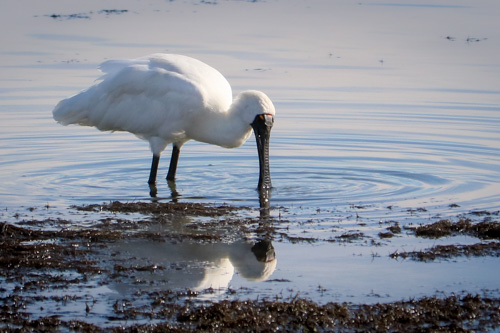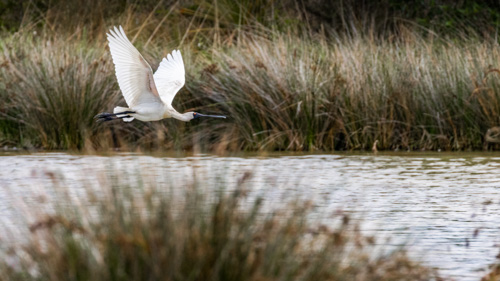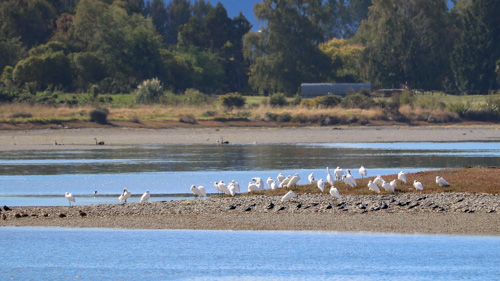New Zealand Royal Spoonbill / Kōtuku ngutupapa
The native Royal Spoonbill (Platalea regia) is a large white wading bird found amidst the breathtaking wetland landscapes of Aotearoa (New Zealand). In a land known for its stunning natural beauty and unique wildlife, the New Zealand Royal Spoonbill stands as a testament to the elegance and adaptability of birds in nature.Royal Spoonbill (Diomedea sanfordi) Kōtuku ngutupapa, Moutere Inlet, Tasman Bay, Motueka, New Zealand

With the Spoonbills striking appearance and intriguing behaviour, this elegant captivating bird has found its niche in the hearts of both nature enthusiasts and conservationists. We delve into the fascinating world of the Royal Spoonbill, a true emblem of New Zealand’s natural heritage.
Name, Species Name, and Family
Royal Spoonbill - Kōtuku ngutupapa - Scientific Name: Platalea regia - Family: Threskiornithidae
Other Names for New Zealand Royal Spoonbill
The Royal Spoonbill (Platalea regia) in New Zealand is referred to by both its Māori name and its English name. Here are the primary and other names used for the New Zealand Royal Spoonbill:
Kōtuku-ngutupapa, kotuku ngutupapa, Kōtuku (Te Reo Māori name), Royal Spoonbill (English name), black-billed spoonbill
The Māori name "Kōtuku-ngutupapa" is unique to New Zealand and reflects the bird's cultural significance and presence in the country.
Description and Identification of the Royal Spoonbill Bird Species
Royal Spoonbill Feeding - Kōtuku ngutupapa, Moutere Inlet, Tasman Bay, Motueka, New Zealand

The Royal Spoonbill (Platalea regia), known as "Kōtuku-ngutupapa" in Te Reo Māori, is a tall wader bird distinguished by its distinctive spoon-shaped bill. While the Royal Spoonbill is found in several regions around the world, including Australia and South-east Asia, the New Zealand population has carved out its unique identity.
One of the most striking features of the New Zealand Royal Spoonbill is its plumage. During breeding season, these majestic birds don an ensemble of striking white feathers, which provide a stark contrast to their black, featherless legs and face. Their beaks are a stunning shade of black, culminating in a spoon-shaped structure that serves a vital purpose in their daily lives.
Habitat, Breeding, and Distribution of Spoonbill in New Zealand
New Zealand Royal Spoonbill breed in coastal colonies and disperse around the country’s wetlands and estuaries, preferring fresh water to salt water, after the breeding season is over.
Nesting for breeding can be high up in the canopy of kahikatea trees. As a wader bird they can also breed at ground level of estuaries, rivers, harbours, in reed beds, and shrubs. At Taiaroa Head and Nugget Point Spoonbill can be found breeding on the rocky headlands.
Royal Spoonbill Flying Through Wetlands, Kōtuku ngutupapa, Watchman Road Reserve, Napier

Royal Spoonbill have a tendency to breed near to colonies of white heron and shag. This is likely a 'safety in numbers' strategy that other different species of bird sometimes employ.
Diet and Unique Royal Spoonbill Adaptations
The hallmark feature of the Royal Spoonbill is, of course, its spoon-shaped bill. This specialized adaptation is perfect for the bird's feeding habits. They are primarily piscivorous, meaning they predominantly feast on fish, but they're also known to consume aquatic insects, crustaceans, and other small invertebrates.
Royal Spoonbills use their magnificent bills as a tool for hunting in shallow waters. Wading silently through the wetlands, they sweep their open bills from side to side, filtering out prey from the mud and water. This fascinating technique highlights the intricate relationship between the bird and its environment, showcasing nature's adaptability and resourcefulness.
New Zealand Royal Spoonbill Survival and Conservation Efforts
Royal Spoonbill Colony Resting, Christchurch, South Island

While the Royal Spoonbill may appear to be flourishing in New Zealand, it is naturally uncommon and their future is not without challenges. Wetland habitats, vital for their survival, are under constant threat from human development, pollution, and climate change. Conservationists and local communities have recognized the importance of safeguarding these habitats and the unique species that depend on them.
Numerous organizations and initiatives in New Zealand are dedicated to protecting the Royal Spoonbill and its wetland habitats. Community-driven efforts, such as habitat restoration projects and educational programs, are playing a crucial role in raising awareness and preserving these essential ecosystems.
Tourism, Royal Spoonbill Habitat Preservation, Education, and Bird Sanctuaries
Royal Spoonbills also play a pivotal role in New Zealand's ecotourism industry. Birdwatchers and nature enthusiasts from around the world flock to New Zealand's wetlands to catch a glimpse of these graceful white birds in their natural habitat. The sight of a Royal Spoonbill gracefully skimming its bill through the water is an unforgettable experience.
Moreover, educational programs and bird sanctuaries help educate both locals and tourists about the significance of these birds in the ecosystem and the importance of preserving their habitats. By connecting people with nature, these initiatives foster a sense of responsibility for the protection of these stunning native New Zealand birds.
The Future for Royal Spoonbill of New Zealand
The New Zealand Royal Spoonbill, with its regal appearance and unique adaptations, stands as a symbol of the country's rich natural heritage. From its spoon-shaped bill to its graceful wading dance in the wetlands and estuaries around the coast, this bird is a testament to nature's ingenuity and resilience. However, the challenges it faces from habitat loss and environmental threats remind us of our responsibility to protect and preserve the precious biodiversity of Aotearoa/New Zealand.
As we appreciate the beauty of the Royal Spoonbill, let us commit to conserving the wetlands and ecosystems that sustain wading birds. In doing so, we ensure that these elegant birds continue to grace our shores for generations to come.
You may also like to investigate my...
List of native New Zealand birds and other wildlife in New Zealand
Names for Spoonbill Birds Worldwide
Spoonbill birds are known by various names across different countries, regions, and languages. Here are some Royal Spoonbill alternative names across the world:
- Black-billed Spoonbill
- Yellow-billed Spoonbill
- Black-faced Spoonbill (for the Australian population)
- Yellow-faced Spoonbill (for the Australian population)
- White Spoonbill
- Platalea regia (scientific name)
- Kōtuku-ngutupapa (Te Reo Māori name in New Zealand)
- Kōtuku (Maori name in New Zealand)
- Spatule royale (French)
- Real Espátula (Spanish)
- Königslöffler (German)
- Reale cucchiaia (Italian)
- Koninklijke Lepelaar (Dutch)
These names reflect the bird's distinct features, its regal appearance, and its geographical distribution.